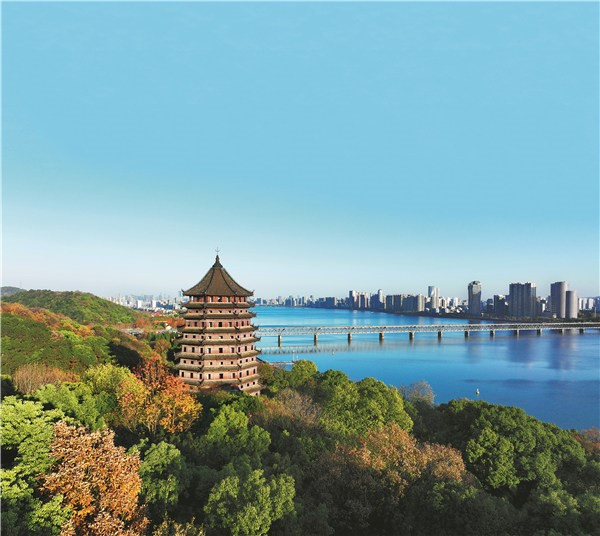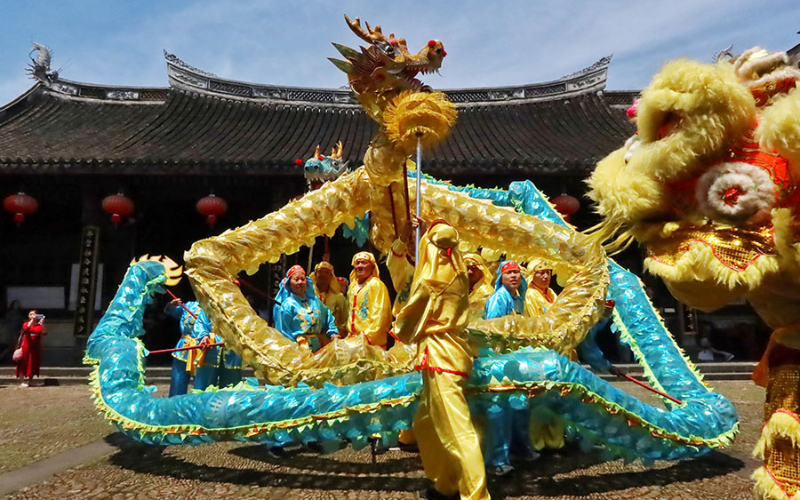Towering determination of pagoda chronicler

Liuhe Pagoda in Hangzhou, Zhejiang province. [Photo by Jia Fei/For China Daily]
Telling the stories of ancient structures is a passionate undertaking for enthusiast, Yang Yang reports.
More than a decade ago, ancient pagoda enthusiast Wu Kai was looking for a book that systematically and comprehensively detailed the total number and locations of the pagodas, and provided introductions with good-quality photos.
"I read a lot of books. But I found that the pagodas they included are limited, with many mistakes and lacking clear logic. I decided to create such a book myself rather than wait for someone to complete the task," he says, adding that, "after all, over the years I have systematically collected and organized plenty of materials".
Wu fell in love with ancient pagodas when he was a student studying physics at Tsinghua University. "I didn't know much about them at first. I just found them appealing to look at," he recalls.
"Ancient Chinese people tended to build large-scale structures, but not tall buildings, and the pagoda was the only tall building they erected that lasts to this day," Wu says. "They are so conspicuous that they became landmark buildings.
"I love them, possibly because they are among the best carriers of Chinese culture."
Originating in India, stupas, dome-shaped structures, were built to enshrine the relics of the founder of Buddhism, Sakyamuni. Nearly 2,000 years ago, stupas were introduced to China along with Buddhism. At that time, Chinese people had already started building multitiered wooden square watchtowers.
Creatively combining the stupa form factor and the watchtower design, Chinese architects created something new — multistoried pagodas, which had the metal spire of a stupa, but the body of a multitiered Chinese wooden square tower.
A portrait brick from the Eastern Han Dynasty (25-220) unearthed in Shifang city of Sichuan province in 1973 reveals the earliest image of a Chinese pavilion-style pagoda — a three-story building.
In the following 2,000 years, pagodas have evolved into many more styles, including dense-eave, Tibetan-style inverted bowl, Vajrasana and Dai-ethnic-style pagodas. The shape of a pagoda body has also developed from square to hexagonal, octagonal or round.
Initially for Buddhist purposes, pagodas were later built to mark the graves of eminent monks or common people, for auspicious purposes or to enhance the landscape.
In addition to the wooden structure at the early developmental stage, there are later pagodas made of brick, as well as a mix of brick and wood, even metal. In modern times, people employ reinforced concrete and steel structures to build antique pagodas.
Apart from wood and bricks, ancient people also used colored glaze, rock, soil, iron, copper, gold and silver in pagoda construction.
It is estimated that there still exist more than 10,000 ancient pagodas across the country, but nobody knows the exact number, since many are anonymous and in disrepair or even just ruins hiding in obscure corners or in the remote wilderness.
To visit hilltop or cliff-top pagodas, or those hidden in deep forest requires fortitude, physical strength and even luck, so, few people get to see them in person. For those that do, there is the added difficulty of taking good-quality photos, especially those suitable for print.
More than a decade ago, blogging was popular in China and many enthusiasts loved to share stories of their visits to ancient pagodas. Through their blogs, they gradually got to know one another.
Wu's plan was applauded by his fellow enthusiasts, many of whom generously offered their photos of pagodas and related materials they had collected.
In the last 10 years or so, Wu has also spent a great deal of time traveling around the country to see pagodas and take photos, systematically collecting and organizing the information about these ancient buildings. In that time, many pagodas have been damaged, moved or lost, so that the photos taken by Wu, or those he got from others, have inadvertently become their final portraits.
After a decade of persistent effort, he has organized firsthand textual and visual materials for nearly 5,000 ancient pagodas.
In 2019, he published his first book on the subject. In the tome, which exceeds 500 pages, Wu includes more than 300 ancient pagodas in Beijing. In addition to archival information, the book also provides maps and more than 800 recently taken high-definition photos, old photos, rubbings, architectural drawings and paintings, making it, to date, the most comprehensive book about ancient pagodas in the region.
Wu planned to create a calendar that introduces an ancient pagoda each day, which later changed to a catalog. He invited veteran enthusiasts to co-write the introductions, but found that people's writing styles varied too much.
In the end, Wang Xuebin, now a scholar studying Chinese ancient pagodas in Henan province, became a co-author of the book.
Wang grew up in Ruzhou, a county-level city in Henan province. His interest in ancient pagodas burgeoned when he was young after hearing legends pertaining to an ancient dense-eave pagoda that stands conspicuously on a top of a hill beside the village where his family lived.
After graduating from university, Wang became a journalist, writing stories about ancient relics, including pagodas.
In 2007, he started sharing his visits to those pagodas in his blogs, and met enthusiasts online, including Wu.
Wang says: "I've been fascinated by ancient pagodas for their profound religious meanings, marvelous architectural structure, great artistic values, and their function of filling in missing parts of historical records that have been lost from mainstream narration, but can still be found inscribed at these ancient monuments."
So far, Henan has recorded more than 700 ancient pagodas, but there must be more to be discovered, Wang says, and his goal is to visit all of them.
Like many enthusiasts, he has been organizing text-based and visual materials about the pagodas in the province, and published several academic papers about auspicious pagodas that emerged during the Ming Dynasty (1368-1644) and pagodas in Henan. The two topics are also what he contributes to the new book he co-authored with Wu.
In October, their weighty 960-page tome about Chinese ancient pagodas was released by China Pictorial Press — Youshengzhinian Yidingyao Kande 1,001 Zuo Zhongguo Guta (The 1,001 Chinese Ancient Pagodas You Must See Before You Die), weighing in at about 3 kilograms.
Alongside the ones that have been listed as national treasures, other precious pagodas that have not entered the list are also featured. It is hailed by many experts as the most comprehensive book in this field.
Ji Huailu, professor at the School of Architecture in Tsinghua University, writes in the recommendation that "the book has established relatively complete archives for top-class ancient pagodas existing in China, and is an important achievement in the study of this area".
The book mainly consists of three parts. Wu uses the first 119 pages to talk about the developmental history of pagodas in China.
In the major second part, the authors make brief but concrete introductions to more than 2,000 pagodas at 680 points that are included in different chapters according to their geographical location. Among them, 960 pagodas are presented on individual pages with text and photos, while 1,000 more pagodas are displayed in groups.
"The '1,001' in the title is not an accurate number of the ancient pagodas included in the book," Wu says. "We introduce the pagodas according to the provinces in which they are located, so as to give readers a route guide if they want to visit them."
The book covers all the provinces, municipal cities and autonomous regions on the Chinese mainland.
The last part includes illustrations about special terms of the pagoda structure, an index and a bibliography.
For Wu, ancient pagodas are not by any means just a pile of rocks or bricks, but old friends that he has not seen for a long time.
"Every time I visit an ancient pagoda, I see not only a cultural heritage item lasting for centuries and the beauty of architecture, but also the simple hearts pursuing perfection and revering nature that, however, have been lost in the hustle and bustle of modern life," he writes in the introduction.
"Although originating from ancient India, unlike stupas, Chinese ancient pagodas are charming for their rich diversity," he writes.
The pagodas built in different historical periods and regions exhibit unique characteristics. Throughout a development of nearly 2,000 years, pagodas have undergone countless changes in form, showcasing a multitude of styles.
"Across the 9.6 million square kilometers of land in China, among the over 10,000 existing pagodas, no two are completely identical," he writes.





